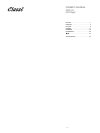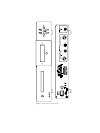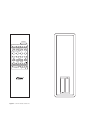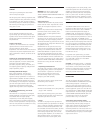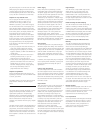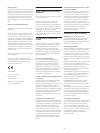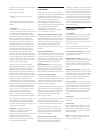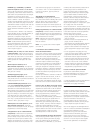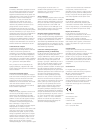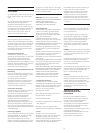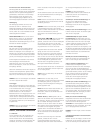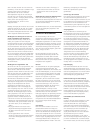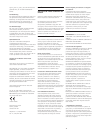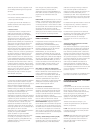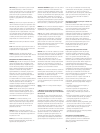
3
play from that point on until the end of the disk.
While playing, the display will show each track
currently playing along with the elapsed time
from the beginning of that track. Once the disk
is over, the CDP-10 will return to STOP mode.
Playback of only selected tracks
You can program the CDP-10 to play any
combination of tracks on a disk, up to a
maximum of 20. Using the NEXT (>) and
PREVIOUS (<) buttons, or the numeric keypad,
find the first desired track on the display. Then
press the PROG button. Repeat this procedure
until all desired tracks have been stored. As each
track is being stored, the display indicates the
total playing time of all tracks currently
programmed. Please note that the front panel
display of the CDP-10 will not show the ‘total
time’ if more than 13 tracks are programmed.
Press PLAY. Playback will commence from the
first programmed track, and all programmed
tracks will play in the order they were stored.
Please note that:
• If you try to program more than 20 tracks, no
more tracks will be entered into memory.
• During programmed playback, the numeric
keypad is disabled; use NEXT and PREVIOUS to
change tracks.
• The programmed tracks don't have to be in
ascending numerical order; i.e. you can
program track 2 to play after track 6.
• To clear all the tracks programmed in memory,
press the STOP button twice if the CDP-10 is
already playing, or once if it is not. If you
intend on changing the disk, simply opening
the disk tray automatically erases all
programmed tracks from memory.
Playback using REPEAT
Pressing the REPEAT button will have the unit
repeating the entire disk. Once the REPEAT mode
is chosen, press PLAY.
The REPEAT feature can also be used with tracks
programmed in memory in the same way as
above.
TECHNICAL DESCRIPTION
The Classé CDP-10 compact disk player is a high
quality unit utilizing the latest innovations in
digital audio reproduction. The philosophy
behind the CDP-10 is advanced technology for
extracting the maximum musical performance,
but also embraces the time proven idea of
simplicity, in accordance with the saying "simpler
is better."
No effort has been spared in the development of
the CDP-10. The chassis is of exceptionally thick
gauge metal, and has been designed to resist
vibration through solid construction and proper
isolation from sources of vibration. The 3/8 inch
thick faceplate is a tribute to its construction and
aesthetics.
Power Supply
Inside, main power is provided by a custom,
encapsulated high-current toroidal transformer.
The power supply of the CDP-10 is generously
oversized to assure that regardless of how much
current is drawn, the circuitry will remain
unaffected by any fluctuations. Multiple stages
of regulation, 11 in total, are used in the power
supply, to assure the elimination of interference
caused by fluctuations often induced by heavy
current draw on shared supplies. The CDP-10
inherently has a low power consumption, but
micro-information is easily contaminated when
traditional power supplies clip due to their
inadequate output. This is the general idea
behind the high current, stable and fully
regulated supply that powers the CDP-10. All the
critical power supply and reference voltages are
bypassed by OSCON capacitors, specially chosen
for their very low electrical series resistance.
Disk Transport
The disk transport itself is the professional type
VAE1250 transport from Philips. This mechanism
is of the latest and newest generation design and
reliably reads all CDs and is also compatible with
CDR and CDRW. The VAE1250 is of very high
quality, and its outstanding construction using
highly efficient, long life motors assures excellent
long-term reliability.
In addition, this compact disk player is designed
not to require periodic calibration, assuring that
long-term alignment will always be right on
specification.
Control Logic Servo Board
The control logic board of the CDP-10 enables
the various digital functions of the transport and
carries all the logical functions that are needed to
operate and initialise the CDP-10. To isolate this
board from the delicate audio processing circuits,
the control board has been located separately
from these circuits.
Output Board
Jitter, also known as errors in the time domain, is
the prime factor in performance degradation,
and Classé has addressed this problem from
every perspective. The output board carries the
master clock, over sampling, digital filter D/A
converters and analogue output stage. The
original Philips transport has a crystal oscillator
directly on the servo board. Since the servo board
is actually a very noisy environment, and also
because the clock used for the transport is also
employed for the critical D/A conversion, we
have decided to remove the oscillator and
reposition it to a cleaner and quieter
environment close to the D/A converter chips.
The converter chips then receives the clock signal
from the output board. This master oscillator has
it’s own local regulator which results in extremely
low jitter (<2ps).
Digital Output
The CDP-10 has a single S/PDIF single-ended
digital output on a very high quality RCA
connector. An added advantage is that the
Isolated Master Clock is also responsible for re
clocking the S/PDIF output. This permits a very
low jitter digital output when the CDP-10 is used
as a digital source transport.
HDCD Decoding and Oversampling
The CDP-10 features an HDCD decoder that, in
addition to allowing full HDCD decoding,
functions as a state of the art oversampling filter
if the input data is not encoded in HDCD format.
A PMD200 HDCD oversampling filter and HDCD
decoder is utilised for that matter. We feel that
this is amongst the best oversampling filters
available. It runs in 8X oversampling mode.
D/A Conversion (Pure Differential Cross
Balance)
The CDP-10 utilises the latest generation D/A
converters from TI/Burr-Brown, the PCM1738,
which are stereo current-output D/A type
(24/192). Each output features a fully differential
push-pull output topology. For the CDP-10, we
have decided to use one stereo chip per channel.
The fully differential output is then used for only
1
/
2
of the signal. This enables much better stereo
separation and fully balanced audio signals. We
do not use quasi-symmetrical outputs sourced
from a single-ended signal converted to balanced
at the output by an inverter stage since this
would be a less than optimal ploy found in many
lesser designs. The CDP-10 utilises eight current
to voltage converters, four per channel. The
signals are converted to a balanced output in
the subsequent stages. Using Pure Differential
Cross Balance™ has an added advantage over
standard differential designs since a dual
balanced amp takes the difference of both
signals halves for the ‘hot’ and ‘cold’ output of
the signal. This means that each of the ‘hot’ and
‘cold’ signals that enter the XLR connector are
derived from four D/A conversion stages.
Remote Handset
Another technical highlight of the CDP-10 is the
custom, solid aluminium remote handset. It
features an exceptionally wide transmission angle
to the IR receiver on the CDP-10, and is
engineered to last an extremely long time.
FCC requirements
Great care has been used throughout the design
and layout of the CDP-10 to meet FCC class B
requirements. This will ensure that the CDP-10
will be insensitive to noisy components in a
system, and in turn will not cause harmful
interference to other components.



